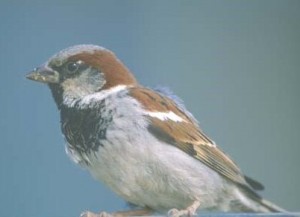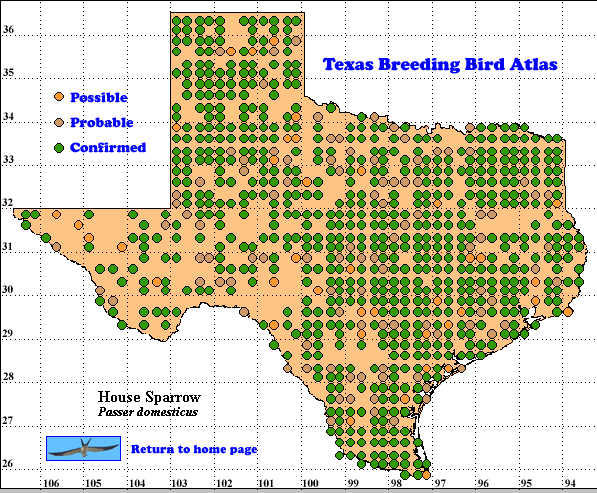 Passer domesticus
Passer domesticus
The House Sparrow is one of the most widespread and abundant birds in the world. It was first introduced into North America in 1850 at Brooklyn, New York, and in 1867, J. M. Brown released two pairs at Galveston, Texas, with subsequent releases at intervals until 1872 (Barrows 1889; Singley 1893). Between 1880 and 1905 the species spread rapidly throughout the state. Dates for the first recorded appearance of the House Sparrow in selected cities and towns in Texas include Jefferson (1882), Houston (1884), San Saba (1886), Brownsville (1889), Gainesville and Waco (1892), San Angelo (1895), San Antonio (1896), Kerrville (1897), Colorado City (1899), Uvalde and Cotulla (1900), Hereford, Alpine, Langtry, and Nuevo Laredo (1901), Valentine (1902), Texline and Canadian (1903), and Corpus Christi (1905). The rapid spread of the House Sparrow is believed to have been accomplished by birds accidentally being transported in box cars from one city to another (Robbins 1973). Notable exceptions to this means of transport include the appearance of the species in Rocksprings, Texas, in 1900 and in Mobeetie, Texas, in 1901, communities not served by the railroad. The House Sparrow today occurs as a permanent resident in all 254 counties of Texas.
The House Sparrow usually spends its entire life in a very small area, but flocks may fly from 3-5 kilometers (2-3 miles) from their roosts to feeding sites in grain fields. Foraging flocks and roosts sometimes contain several hundred birds (North 1973). House Sparrows may greatly outnumber all other species of native birds in some areas of Texas, e.g. in Hale County House Sparrows were found during 1965 to comprise 71% of the adult bird population (Hayes, LaMotte and Holden 1967).
DISTRIBUTION: The House Sparrow is a resident breeding species in all regions of Texas. It is particularly abundant in agricultural areas and its distribution closely parallels that of the human species with whom it lives as an associate. Because of this close relationship, the nestlings of House Sparrows on the Texas High Plains have been identified as important reservoir hosts of the viruses that cause western and St. Louis encephalitis. These viruses are transmitted from the birds to humans by mosquitoes (Hayes, LaMotte and Holden 1967). House Sparrows adapt well to artificial conditions and have been successfully bred in captivity (Mitchell and Hayes 1973).
SEASONAL OCCURRENCE: Little evidence exists to support the statement of Oberholser (1974) that House Sparrows breed throughout the year. This assumption is apparently based on the observation that the birds may often be seen carrying nest material several weeks before the eggs are laid (Harrison 1975).
Sexual display may, however, begin as early as February followed by the building of nests in protected locations. Egg laying in Hale County has been observed as early as 18 March and to extend through the middle of August. This same population of sparrows produced 1-6 clutches with 1-6 (avg. 4) eggs per clutch (Mitchell, et al. 1973). In contrast, Oberholser (1974) gives the number of eggs produced as 4-9 with the usual number being 5-6.
The TBBA data document nests as early as March 24 in latilong 32095, Quad G8 and as late a Julys 24 in Latilong 33095, Quad C8. The majority of confirmed records obtained by the TBBA dates are based on finding nests with eggs or young
BREEDING HABITAT: The nests of House Sparrows are built by both sexes and are most commonly found associated with or near human structures. Nests may be placed low or as much as 15-18 meters (50-60 feet) above the ground with preferred sites being under the eaves of houses, holes and crevices in buildings or open tree sites. Nest boxes placed for other species are quickly appropriated by House Sparrows. Nests built in trees are generally covered, with an entrance hole in the side. The outer layer consists of grasses or straw and an inner lining of softer materials such as feathers, hair, string, or fine grasses. Nests are commonly used from year to year. House Sparrows are slightly territorial and will defend the area immediately surrounding the nest (Summers-Smith 1963). The House Wren and European Starling are competitors for nest sites and both are known to destroy the eggs of the House Sparrow (Kalmbach 1940)
STATUS: House Sparrows were originally protected in Texas by an 1883 law that prohibited the killing of any “sparrow.” They are no longer protected and are generally considered to be a nuisance species that occasionally must be controlled on a local basis. The breeding distribution of the House Sparrow in Texas has not significantly changed since the publication of Oberholser’s account in 1974. It is probable, however, that the increasing urbanization of Texas during the past 40 years has altered the density of sparrow populations in many areas. See also Lowther amd Cink (1992).
Text by Stan D. Casto (Posted 2006)
MapLiterature cited.
Barrows, W. B. 1889. The English Sparrow (Passer domesticus) in North America, especially in its relation to agriculture. U. S. Dept. of Agric., Div. of Econ. Ornithol. and Mammal., Bull. No. 1.
Harrison, H. H. 1975. A field guide to birds nests. Houghton Mifflin, Boston, MA.
Hayes, R. O., L. C. LaMotte, and P. Holden. 1967. Ecology of arboviruses in Hale County, Texas, during 1965. Am. J. Trop. Med. 16: 675-687.
Kalmbach, E. R. 1940. Economic status of the House Sparrow in the United States. U. S. Dept. of Agric’ Tech. Bul. No. 711.
Lowther, P. E. and C. E. Cink. 1992. House Sparrow (Passer domesticus). In The birds of North America, No. 12 (A. Poole and F. Gill, eds.). The Birds of North America, Inc., Philadelphia, PA.
Mitchell, C. J., and R. O. Hayes. 1973. Breeding House Sparrows in captivity. In Sympos. on the House Sparrow (Passer domesticus) and European Tree Sparrow (P. montanus) in North America,_ pp. 39-48. Ornithol. Monogr. No. 14,
Mitchell, C. J., R. O. Hayes, P. Holden, and T. B. Hughes, Jr. 1973. Nesting activity of the House Sparrow in Hale County, Texas, during 1968. In Sympos. on the House Sparrow (Passer domesticus) and European Tree Sparrow (P. montanus) in North America, pp. 49-59. Ornithol. Monogr. No. 14.
North, C. A. 1973. Movement patterns of the House Sparrow in Oklahoma. In Sympos. on the House Sparrow (Passer domesticus) and European Tree Sparrow (P. montanus) in North America, pp. 79-91. Ornithol. Monogr. No. 14,
Oberholser, H. C. 1974. The bird life of Texas, University of Texas Press, Austin.
Robbins, C. S. 1973. Introduction, spread, and present abundance of the House Sparrow in North America. In Sympos.on the House Sparrow (Passer domesticus) and European Tree Sparrow (P. montanus) in North America, pp. 3-9. Ornithol. Monogr. No. 14.
Singley, J. A. 1983. Notes on the birds of Galveston Island. Fourth Ann. Rep. Geol. Surv. of Texas for 1892, pp. 355-375.
Summers-Smith, J. D. 1963. The House Sparrow. Collins, London, UK.
